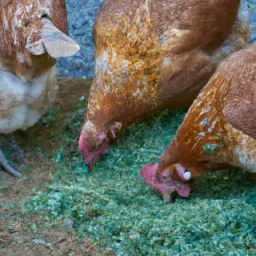Discover the Best Chicken Feed for Your Flock with These Top Picks
Chickens are a popular choice among many farmers and homeowners as they provide fresh eggs, meat, and even entertainment.
However, to keep your flock healthy and productive, you need to ensure that they have access to high-quality chicken feed.
So let’s discuss everything you need to know about the chicken feed consumption chart, types of chicken feeds available in the market, top picks for your flock, how to store and maintain chicken feed, and more.
Let’s get started, shall we?
1. Consumption Chart:
Before choosing a type of chicken feed, it is essential to understand your bird’s daily food requirements.
The amount of feed required by each bird depends on its age, breed, weight, and activity level.
A general rule of thumb is to offer one pound of feed per bird per week.
You can also consult with an expert veterinarian or local extension agent to determine the appropriate feeding schedule based on your specific needs.
2. Types of Chicken Feed:
Several types of chicken feed are available in the market today, including layer feed, starter feed, grower feed, and maintenance feed.
Layer feed is designed specifically for hens who produce eggs regularly, while starter feed is ideal for young birds up to six weeks old.
Grower feed is used during the growing phase from six weeks to twelve months, and maintenance feed is suitable for mature birds over twelve months old.
Each type of feed has unique nutrient content tailored to meet the specific dietary needs of your flock.
3. Best Chicken Feeds:
When selecting the best chicken feed for your flock, there are several factors to consider such as quality, price, and availability.
See also Chicken Feeding 101: Understanding Your Flock's Nutritional Needs

Here are some top picks for your flock:
a) Organic Feed – This type of feed is made without synthetic fertilizers, pesticides, genetically modified organisms (GMO), or ionizing radiation. It provides a natural source of nutrition for your birds.
b) Non-GMO Feed – As the name suggests, the non-GMO feed contains no genetically modified ingredients. It is a great option for those who prefer a natural approach to raising their flock.
c) Omega-3 Enriched Feed – This type of feed contains added omega-3 fatty acids which promote healthy plumage, skin, and egg production.
d) Pelleted Feed – Pelleted feed is easy to digest and highly palatable, making it a favorite among many flock owners.
4. How to Store and Maintain Chicken Feed:
Proper storage and maintenance of chicken feed are crucial to ensure that your flock receives the necessary nutrients and remains healthy.
Here are some tips to help you maintain your feed supply:
a) Keep feed dry and cool – Moisture and heat can cause the feed to spoil quickly, so make sure to store it in a dry place away from direct sunlight.
b) Use insect-proof containers – Rodents and insects can contaminate feed, so use tightly sealed containers to prevent infestations.
c) Rotate feed supplies – Regularly rotate your feedstock to avoid excess accumulation of old feed.
d) Clean feeders regularly – Dirty feeders can harbor bacteria and disease, so clean them at least once a week using hot water and soap.
By providing your flock with high-quality chicken feed is essential to keeping them healthy and productive.
See also Is a Mobile Chicken Coop Right For Your Backyard Flock
By understanding your bird’s daily food requirements, choosing the right type of feed, and following proper storage and maintenance techniques, you can ensure that your flock gets all the nutrients they need to thrive.
